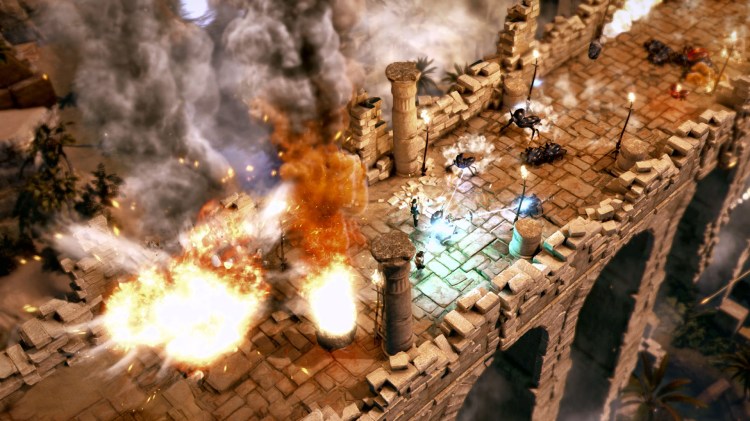Each character ends up with different abilities. Many items players equip affect only their own power. But amulets boost the group as a whole, leading to another fun bit of coordination as you attempt to stack the maximum amount of buffs on your party. Treasure isn’t split equally, especially as people die, so a friendly element of competition naturally sneaks in.
What you won’t like
Running away for the win
Lara isn’t much of a brawler in Lara Croft and the Temple of Osiris. She has no melee moves, and her ranged weapons have a dead zone at point-blank range (for either enemies or jewel-containing pots), which can be irritating.
The game uses a free-aim system that can be actively frustrating. Pressing the trigger to fire does nothing until you aim using the right analog stick. The system allows you to fire in any direction while moving, though it slows your run speed considerably. It feels clunky.
The system sometimes makes the right trigger seem like a superfluous button. You’re already having to move the right stick to aim, so why not have the stick also control the firing? Or why not allow firing whenever the trigger is down but continue to allow changing directions of fire by aiming?
Either way, the mechanic feels strange, especially if you’re used to titles that allow the use of the right stick to look. The camera angle is locked here in the game’s three-quarter overhead view.
Most weapons fire relatively weakly, and Lara is squishy and easy to kill. I ended up doing a ton of kiting: running enemies around and around an area while I paused to shoot or blow them up with bombs. This tactic greatly simplified the experience since a Lara on the move tends to be a Lara that stays alive.
Inaccurate controls lead to a few too many landings on spikes
Lara’s side objectives include collecting items (usually via some jumping/platforming tests) and getting rid of enemies in particular ways. You might have to lead hostiles into traps or put them in harm’s way with a boss for example (friendly fire is a thing for the bad guys).
The actions require precision in the controls, and Lara doesn’t always live up to that expectation. In particular, I found the lack of accuracy in jumps and rolls to be an issue, and the controls while rappelling up or down a wall — especially when you need to move from side to side — feel smushy and unresponsive.
You probably won’t notice too much as you run through a level, but if you’re trying for the fancy moves, you’ll likely get frustrated.
Egyptian temple stereotypes swarm like scarabs
This Lara effort employs every temple-and-tomb trope in the book. Skeletons and scarabs attack. Spikes shoot up from the floor. Pots contain gems familiar in shape and size to anyone who’s ever played a Legend of Zelda adventure. From the circles on the ground at the characters’ feet to the jump, roll, and run of fast platforming sections, many of the elements in this title settle for refining everything that’s come before.
Don’t get me wrong. Nothing is particularly objectionable about Lara Croft’s challenges. Still, despite the twists of things like the weather or day/night (all of which you control) affecting enemies and traps, many of these levels feel a little to similar to each other and what you’ve already played before.
Conclusion
If you’re looking for an old-school retro dungeon crawler, Lara’s latest adventure might scratch that itch, though Diablo III: Reaper of Souls is better at the classic smash and grab.
The light puzzles and strong couch and online co-op elements make this game a hoot to play with friends. It’s especially attractive for families or friends of different ages or skill levels who play together. (It’s rated Teen.)
Lara Croft and the Temple of Osiris gets solid points for execution and beauty, but it could have used an injection of creativity. Still, at $20, this arcade-style title offers great play for the money.
Single-player score: 75/100
Co-op score: 85/100
Lara Croft and The Temple of Osiris launches Dec. 9 for Xbox One, PlayStation 4, and the PC. Square Enix provided GamesBeat with a download code for this review.
VentureBeat's mission is to be a digital town square for technical decision-makers to gain knowledge about transformative enterprise technology and transact. Learn More





